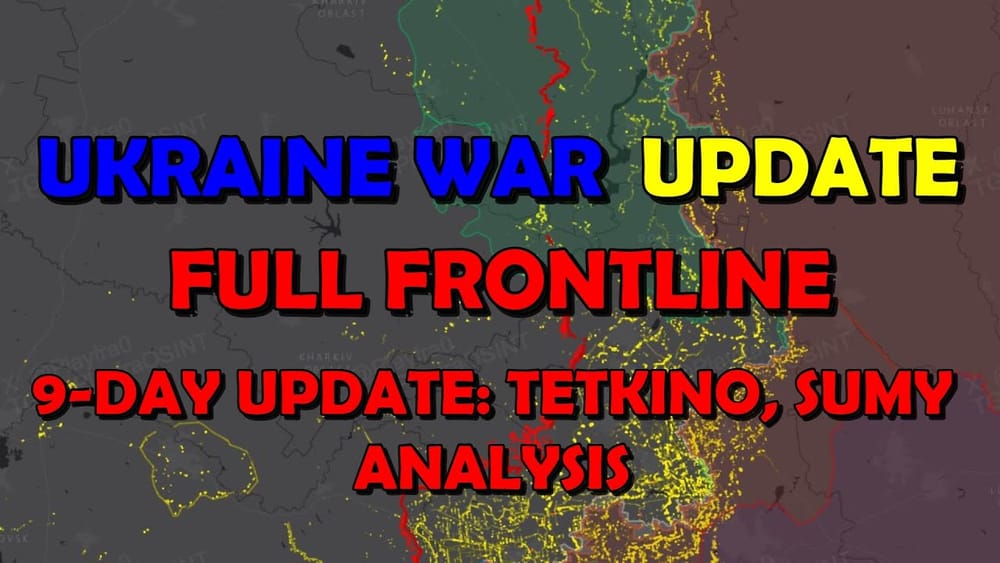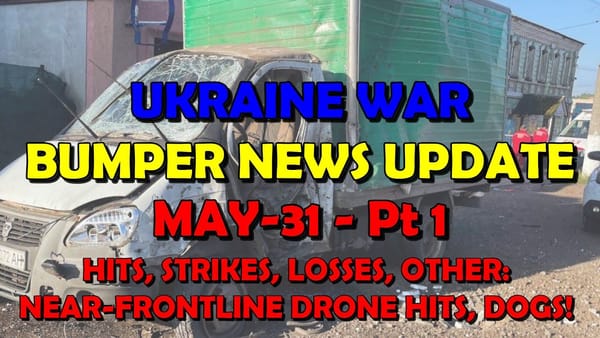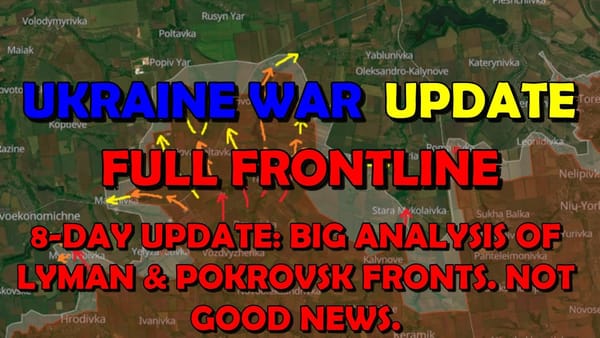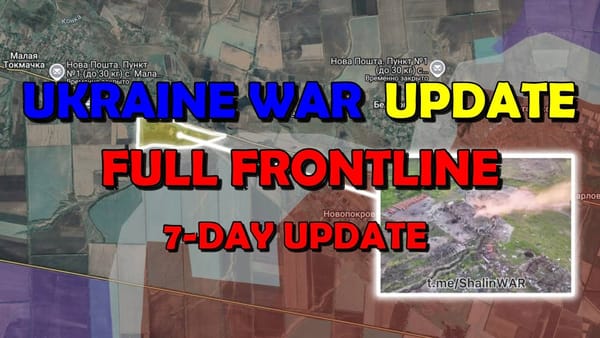Ukraine Conflict: 9-Day Full Frontline Update - Sumy, Tekino Analysis
Table of Contents 📖
| Topic ID | Topic Title | Timestamp |
|---|---|---|
| 1 | Hello Team | 00:00-01:36⏩ |
| 2 | Kursk Region: Tetkino Encirclement and Russian Weaknesses | 01:36-08:42⏩ |
| 3 | Sumy Region: Russian Advances and High Casualties | 08:42-14:42⏩ |
| 4 | Sumy Region: Russian Objectives and Outdated Ukrainian Fortifications | 14:42-21:42⏩ |
| 5 | Sumy Region: Proposed Ukrainian Defensive Strategies | 21:43-29:02⏩ |
| 6 | Sumy City: Strategic Importance and Long-Term Survivability | 29:02-30:26⏩ |
| 7 | Vovchansk and Kharkiv Front Updates | 30:38-32:56⏩ |
| 8 | Eastern Front: Pishchanka, Zherebets and Kupyansk Bridge | 32:57-35:26⏩ |
| 9 | Chasiv Yar and Turetsk Front: Russian Grinding Advances | 35:26-43:57⏩ Return to top⤴️
Over a two-week period, the map shows a high number of Russian pins, indicating many advances. North of Chasiv Yar, Suriyak Maps shows continued Russian gains, while Andrew Perpetua shows some gains within Chasiv Yar itself. The situation in Chasiv Yar is becoming more precarious, potentially threatening Kostyantynivka. Jonathan notes that Chasiv Yar was expected to fall a year ago, but Ukrainian forces continue to hold.
Small gains are seen around Vasyukivka, potentially recapturing grey zone areas. Russians are making advances in many areas, including north of Toretsk. Andrew Perpetua shows some Russian advances from the railway junction, while Suriyak Maps shows more significant gains north of Toretsk. Fighting remains tough in Toretsk, and while claims of Russians being in the city centre haven't been confirmed, the slow, grinding increases in Russian control are worrying as Kostyantynivka is slowly encroached upon. Scruffy Tales' analysis indicates that these 300m/day advances, while cumulative over a month, come at a huge cost in casualties and represent an orderly withdrawal by Ukrainians, not a collapse.
Returning to Playcry's analysis on Toretsk, Jonathan notes that Russian advances northeast of the city (e.g., Dylivka) are slower than they appear. A major concern is Yablunivka, where the western part has been captured by Russians who are pushing further, threatening to bypass Kostyantynivka and cut off the Ukrainian garrison in Toretsk. Ukrainians still hold positions on the northern and western outskirts of Toretsk. Russians are attacking a spoil heap (Terracon) northwest of the city, which Andrew Perpetua previously marked as grey zone. A significant challenge for Ukrainians in Toretsk is the prevalence of Russian "Hunter" drones equipped with nets and anti-drone equipment, which deny Ukrainian forces drone support in the city.
Return to top⤴️ Dnipropetrovsk Oblast Border Threat |
| 11 | Kamianske Sector and Overall Frontline Outlook | 48:19-51:17⏩ |
| 12 | Wrap up | 51:17-51:20⏩ |
Hello Team
🎦 00:00-01:36⏩
Jonathan M.S. Pearce welcomes viewers to an ATP Geopolitics Ukraine War Frontline Update for 6th June 2025, commemorating D-Day. He apologises for the delay, noting this is the longest he's gone without a frontline update (two weeks), attributing it to recent political upheaval and intense military actions from both sides. He explains his use of two mappers: Andrew Perpetua (more objective) and Suriyak Maps (pro-Russian, aligned with their Ministry of Defence), highlighting that their differences in opinion lead to varied reporting on front line changes. Jonathan clarifies the map pin colours: dark blue/cherry red for Suriyak Maps, and lighter blue/pink for Andrew Perpetua, indicating Ukrainian and Russian movements respectively.
Return to top⤴️
📍 FRONT-LINE UPDATE -🗺️ MAP LEGEND
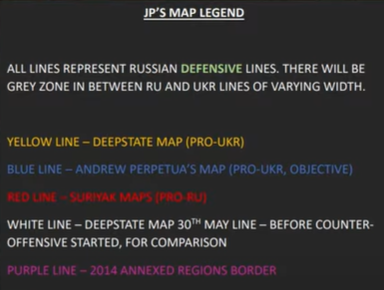
Kursk Region: Tetkino Encirclement and Russian Weaknesses
🎦 01:36-08:42⏩
Jonathan begins with the Kursk direction, specifically Tetkino, where Ukrainian forces have made notable advances, a rare occurrence with more blue (Ukrainian) pins than red (Russian). The Russians are pushing back in the Sumy area, south of Kursk, but Tetkino itself appears to be surrounded. While not a classic encirclement, Ukrainian control of the river to the west and advances along tree lines to the south mean supply routes for Russian troops in Tetkino are severely limited and under fire/drone control, making resupply "suicidal". Jonathan highlights Russian complaints about lack of air defence, allowing Ukrainian aviation, drones, and artillery to heavily target Russian forces. He quotes a French thread reporting on desperate Z-channels (pro-Russian Telegram channels) confirming the encirclement, stating, "All logistics have been cut off." Russian channels admit the Ukrainian Armed Forces have advanced into the centre of Tetkino and from the southeast towards Popovo-Lezachy. Despite a "catastrophic situation", Russian command has not authorised withdrawal or reinforced troops, seemingly abandoning them. Jonathan criticises this, citing a Russian source who argued, "heroes, you don't leave heroes to be annihilated." He notes that Deep State has not fully confirmed the encirclement, but indicates Ukrainian control of 11 sq km in Kursk region, with 10 sq km as a combat (grey) zone. HIMARS and drone strikes have also targeted Russian personnel and staging areas in Rylsk, a command and control hub.
Return to top⤴️
Sumy Region: Russian Advances and High Casualties
🎦 08:42-14:42⏩
In the Sumy region, the situation is challenging for Ukrainians, with Russians making substantial advances. Optimistically, these gains are reportedly in the land between the border and the main Ukrainian defensive lines. Taking villages like Unikivka will require Russians to cross open fields, making them vulnerable. Andrew Perpetua previously noted that the forest area beyond this initial advance would be very difficult to take. Jonathan cites Scruffy Tales' analysis on Russian casualties versus land gains:
- In 2024, Russia gained only 0.69% of Ukrainian territory at a cost of 150,000 dead and 400,000 overall casualties.
- 2025 is on track to be similar, with 150,000-160,000 casualties so far, equating to approximately 99 casualties per square kilometre gained.
Jonathan questions how long Russia can sustain such losses, noting they are resorting to co-opting Coast Guards for the front line and using convicts. He points out a decline in Russian heavy combat equipment, with an increased reliance on motorcycles and quads, indicating a fundamental lack of decent gear. North Korean Coxan M1989 artillery is now seen on the eastern front. A user comment from David D highlights Russia's deployment of elite forces (VDV divisions/brigades, Marines, artillery – 25,000-50,000 troops) into Sumy. This raises a strategic dilemma for Ukraine: commit reserves to a counterattack now or save them for a potential summer offensive. Jonathan reflects on previous tactical decisions, like in Kursk, where Ukrainian supply lines were cut. He discusses improved Ukrainian air support, with F-16s using guided glide bombs against Russian logistics.
Return to top⤴️
Sumy Region: Russian Objectives and Outdated Ukrainian Fortifications
🎦 14:42-21:42⏩
Tendar corroborates that Russians have gained villages south of Sumy without breaking main lines, while Ukrainians pressure Tetkino. Jonathan then delves into Playcry's detailed thread from June 5th, which outlines Russia's new front in Sumy, aiming to control supply routes to Shelyt. Initial Russian advances towards Novenka were bogged down by Ukrainian drones and regrouped brigades. Russia responded by extending the front to threaten encirclement, forcing a Ukrainian retreat. Playcry suggests this retreat wasn't orderly, allowing Russian exploitation. Jonathan, however, notes Scruffy Tales believes Russian advances are slow (300m/day) and costly, indicating an orderly withdrawal rather than capitulation. Playcry confirms Russian consolidation along the Kindretivka, Oleksivka, Belovody, and Basivka line, which serves as a springboard for further southward expansion. To reach Sumy city, Russians must break the strong Yastruburne-Khotyn-Yanukivka line, located on a dominant hill ridge with a large forested area that offers camouflage for troop and vehicle accumulation. A critical point from Playcry is that Sumy's fortifications, built in 2023, are now "outdated" due to the evolution of drone warfare, especially fiber optic drones. While visually imposing, soldiers avoid open trenches, preferring camouflaged positions within tree lines which offer better protection. Trenches are vulnerable to FPV drone swarm attacks, forcing retreats to exposed dugouts. This highlights the war's innovative nature and the critical importance of camouflage.
Return to top⤴️
Sumy Region: Proposed Ukrainian Defensive Strategies
🎦 21:43-29:02⏩
Playcry suggests crucial fixes for Ukraine's defensive strategy:
- Building "Guts" (covered trenches) within tree lines: He cites Russian success near Vobove in 2023. These camouflaged systems render reconnaissance almost impossible. Ukrainian engineers must use small excavators that dig between trees, maintaining camouflage and allowing closer-to-frontline construction.
- Developing strong points in forested areas northeast of Sumy: Creating a "swamp" for Russian forces, similar to Kramina, by building interconnected trench systems and placing drone operators there. This terrain, with hard slopes, dense greenery, clearings, and even lakes, could turn the area into a "living hell" for Russians.
- Planning orderly retreats to the Yastrobina-Khotyn-Yanukivka line: Preventing disorganised withdrawals and ensuring Russians don't gain advantageous positions. Blowing bridges over the Oleshnya River (which passes through most towns on the line) and establishing kill zones controlled by forest-stationed drones are suggested.
- Reinforcing the Pisarivka-Yasturbina line: This line is easier to break through than the Pisarivka-Yunikivka one, making it a natural bottleneck. Using the forest as a barrier, layered defences can be created.
- Buying time for the Richki-Mikolaivka-Stretkivka line to be reinforced: Emphasising the importance of tactical withdrawals to conserve manpower rather than stubbornly holding unsustainable positions.
Jonathan acknowledges these steps are easier said than done, requiring time and effort, both limited for Ukraine. He concludes Playcry's analysis by agreeing that Sumy city itself is unlikely to be captured by Russia due to its size (145 sq km, much larger than Bakhmut or Pokrovsk), its natural defensive characteristics (rivers, high-rise areas, industrial zones, eastern forest), and the "topographical and orographic nightmare" for any attacker.
Return to top⤴️
Sumy City: Strategic Importance and Long-Term Survivability
🎦 29:02-30:26⏩
Jonathan concludes Playcry's analysis by strongly agreeing that Sumy city will not fall. He emphasizes that Russia's objective is not to capture the city, but to take the Khotyn Heights. From this vantage point, they can shell and strike Sumy city with drones, rendering it "dead" and "unlivable", much like Kherson. This would prevent the city from contributing to the economy or functioning as a society, which is the primary concern, not its physical capture. Getting artillery and FPV drones within range means Sumy would face daily barrages, making it uninhabitable.
Return to top⤴️
Vovchansk and Kharkiv Front Updates
🎦 30:38-32:56⏩
Jonathan moves to the Vovchansk direction, where Andrew Perpetua's maps show slight Ukrainian gains, particularly around the monastery. Suriyak Maps, however, indicates Russian advances further southwest. In the Kharkiv area, some gains have been made by Ukrainians in the eastern sector around Stara Tsyr and Borodovka. However, the Russians are regaining control within Vovchansk itself, pushing closer to the river. This is worrying, as Ukrainians had success here earlier, possibly due to Russia's distraction with Kursk. Jonathan questions why Russia hasn't pushed across the border north of the Oskil River more, instead of struggling with river crossings, suggesting this area might be heavily mined and protected. He notes that Russia's "chip away, chip away" strategy, though slow, accumulates significant territorial control.
Return to top⤴️
Eastern Front: Pishchanka, Zherebets and Kupyansk Bridge
🎦 32:57-35:26⏩
On the eastern/northeastern front, there has been no change in the Pishchanka sector for two weeks, which Jonathan deems significant. While mappers show differences, Ukrainians have been pushing back south of this area. However, there's been considerable Russian momentum across the Zherebets River, west of Terny, which is a worry. Jonathan notes that the Ukrainians seem to have pushed back north of Torska, though this could be a map rejig. He highlights news from Tim White today (June 6th) of Russia destroying a bridge near Kupyansk on the Oskil River. This bridge has been previously blown up. While its exact location is uncertain, Jonathan suggests it might be the bridge south of Kupyansk, given the visual evidence of a permanent structure. The destruction of this bridge represents a significant explosion.
Return to top⤴️
Chasiv Yar and Turetsk Front: Russian Grinding Advances
35:26-43:57⏩
Return to top⤴️Over a two-week period, the map shows a high number of Russian pins, indicating many advances. North of Chasiv Yar, Suriyak Maps shows continued Russian gains, while Andrew Perpetua shows some gains within Chasiv Yar itself. The situation in Chasiv Yar is becoming more precarious, potentially threatening Kostyantynivka. Jonathan notes that Chasiv Yar was expected to fall a year ago, but Ukrainian forces continue to hold. Small gains are seen around Vasyukivka, potentially recapturing grey zone areas. Russians are making advances in many areas, including north of Toretsk. Andrew Perpetua shows some Russian advances from the railway junction, while Suriyak Maps shows more significant gains north of Toretsk. Fighting remains tough in Toretsk, and while claims of Russians being in the city centre haven't been confirmed, the slow, grinding increases in Russian control are worrying as Kostyantynivka is slowly encroached upon. Scruffy Tales' analysis indicates that these 300m/day advances, while cumulative over a month, come at a huge cost in casualties and represent an orderly withdrawal by Ukrainians, not a collapse. Returning to Playcry's analysis on Toretsk, Jonathan notes that Russian advances northeast of the city (e.g., Dylivka) are slower than they appear. A major concern is Yablunivka, where the western part has been captured by Russians who are pushing further, threatening to bypass Kostyantynivka and cut off the Ukrainian garrison in Toretsk. Ukrainians still hold positions on the northern and western outskirts of Toretsk. Russians are attacking a spoil heap (Terracon) northwest of the city, which Andrew Perpetua previously marked as grey zone. A significant challenge for Ukrainians in Toretsk is the prevalence of Russian "Hunter" drones equipped with nets and anti-drone equipment, which deny Ukrainian forces drone support in the city.
Return to top⤴️
Dnipropetrovsk Oblast Border Threat
🎦 43:57-48:18⏩
Russians are reportedly very close to the Dnipropetrovsk Oblast border, only a couple of kilometres away, according to Deep State maps for June 5th, specifically near Novopavlivka and Troitska. While some initial claims of 560 meters were refuted, the current 2,020 meters is still a significant threat. Jonathan shows how close the Russians are to various areas of the Dnipropetrovsk Oblast. There's a major discrepancy between mappers here: Suriyak Maps shows Russians controlling a large area of the border where Deep State and Andrew Perpetua indicate no Russian control. This highlights the strategic risk: if Russians gain a foothold, they might quickly incorporate it into their constitution as Russian territory. Ukrainian forces are fighting hard to hold them back, particularly in what was the Velykonovosilka sector, where there are continued Russian pushes towards the border.
Return to top⤴️
Kamianske Sector and Overall Frontline Outlook
🎦 48:19-51:17⏩
In the Kamianske sector, Ukrainians appear to have had some success, pushing back against Russian forces. Jonathan notes that this area has been dynamic, with Ukrainian pushbacks occurring multiple times in recent months. Both Andrew Perpetua and Suriyak Maps indicate Ukrainian gains around Kamianske. Despite these localized successes, the overall situation remains challenging for Ukrainians, with Russians making gains in several places, particularly in Sumy. Jonathan discusses Ukraine's potential responses: continuing to focus on hitting targets at distance with their drone production (long and medium range), and potentially increasing close air support or using guided glide bombs to target Russian forces. He emphasizes the need for Ukraine to stem the flow of Russian advances across the front lines, acknowledging that this comes at a significant cost. Jonathan then briefly mentions that he has a thread on Ukrainian efforts to build new defensive lines in Donbas, further back from the front, including tank ditches and other fortifications, to prevent being caught unprepared as they were in areas like Avdiivka. He saves this for a future video.
Return to top⤴️
Wrap up
🎦 51:17-51:20⏩
Jonathan signs off, wishing the team well and promising to speak to them soon.
Return to top⤴️
🤖❓ AI Debrief (post task) - anything the AI didn't understand
0123456789
